ZAN Xingjie's Research Group
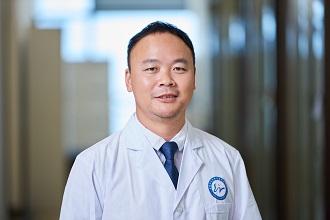
Group Name
Biological interface research group
Principal Investigator
Dr. Prof. Zan Xingjie
Wenzhou Institute, UCAS
Email: zanxj@wiucas.ac.cn
Wenzhou Institute, UCAS
Email: zanxj@wiucas.ac.cn
Education
- Changchun Institute of Applied Chemistry, Chinese Academy of Sciences; Changchun, Jilin, China
- Ph.D. Polymer Physics and Chemistry, Feb. 2010.
- Chinese Academy of Sciences, Changchun, Jilin, China
- B.S. Chemistry Education, Jun. 2004.
Research Expereices
- Mar. 2010 -- Jun. 2012 Postdoctoral Fellow , University of South Carolina, Columbia, SC, USA
- Aug. 2012 – Sep. 2014 Postdoctoral Fellow, University of South Carolina, Columbia, SC, USA
- Sep. 2015 – Jun. 2017 Humboldt Research Fellowship for Experienced Researchers, Leibniz Institute of Polymer Research, Dresden, German
Awards
- Award of “Overseas Elite Talent Programme of Wenzhou” in 2015;
- Award of “Humboldt Research Fellowship for Experienced Researchers” in 2015
Funding Sources
- National natural science foundation of China
- Alexander von Humboldt foundation
- Wenzhou Science & Technology Bureau
- Major & Special Projects of Wenzhou Institute of UCAS
Research
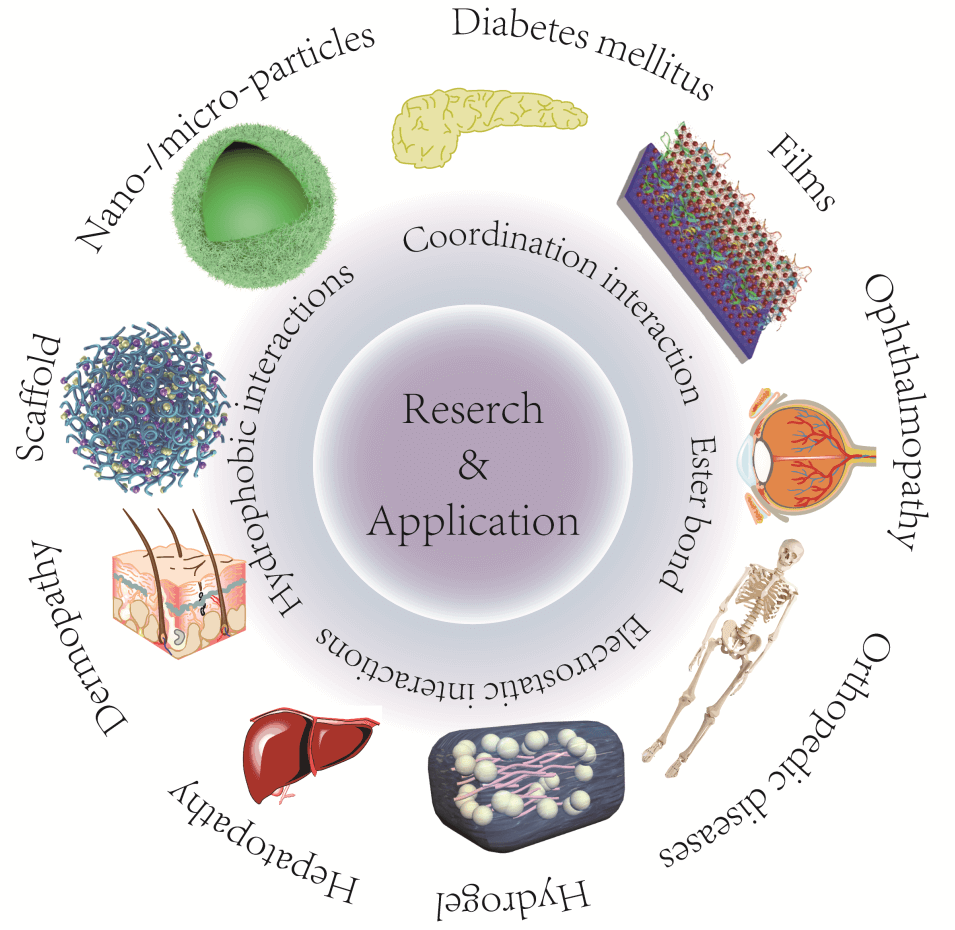 In recent years, our group has focused on delivering active proteins and developing protein materials for disease treatment and tissue engineering. At present, we has constructed a series of active protein delivery systems, including nanoparticles, micro/nano-vesicles, hydrogels, through 1) the coordinative interaction between polypeptide/protein/natural polymer and metal ions, and 2) the multiple interactions between polypeptide/protein and plant polyphenols. And these systems are applied in treating various diseases and tissue regeneration, including diabetes, ophthalmic related diseases, liver related diseases, skin regeneration, bone related implants, etc.
In recent years, our group has focused on delivering active proteins and developing protein materials for disease treatment and tissue engineering. At present, we has constructed a series of active protein delivery systems, including nanoparticles, micro/nano-vesicles, hydrogels, through 1) the coordinative interaction between polypeptide/protein/natural polymer and metal ions, and 2) the multiple interactions between polypeptide/protein and plant polyphenols. And these systems are applied in treating various diseases and tissue regeneration, including diabetes, ophthalmic related diseases, liver related diseases, skin regeneration, bone related implants, etc.
Native protein delivery
Proteins play an important role in the diseases treatment. However, due to the fragility, the protein could be fast degraded by enzymes and lose their biological activity when administrated in traditional way (oral or intramuscular injection). We developed a variety of protein delivery vehicles, studied their effects on protein encapsulation, activity maintenance, responsive release, intracellular delivery, and carried out their therapeutic effects in a different disease models.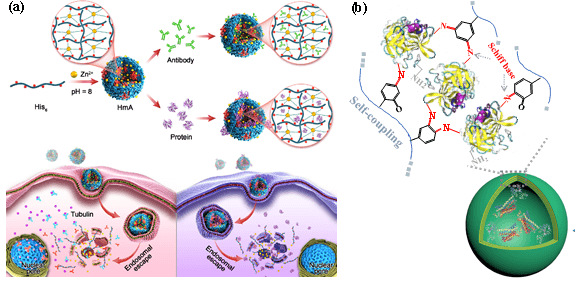
The effect of physicochemical properties on the destiny of nano-medicine
With the development of nanotechnology, nano-medicines (drug loaded nanoparticles) bring light to many previously incurable diseases due to its ability to greatly change the pharmacokinetics. It is the key to control the fate and behavior of nano-medicines in cells and in vivo, which could be largely affected by the physicochemical properties (particle size, shape, mechanical properties and surface chemistry). We concentrated on how these physicochemical properties influence the in vitro and in vivo behaviors of nano-medicine, with the purpose to improve clinical outcomes.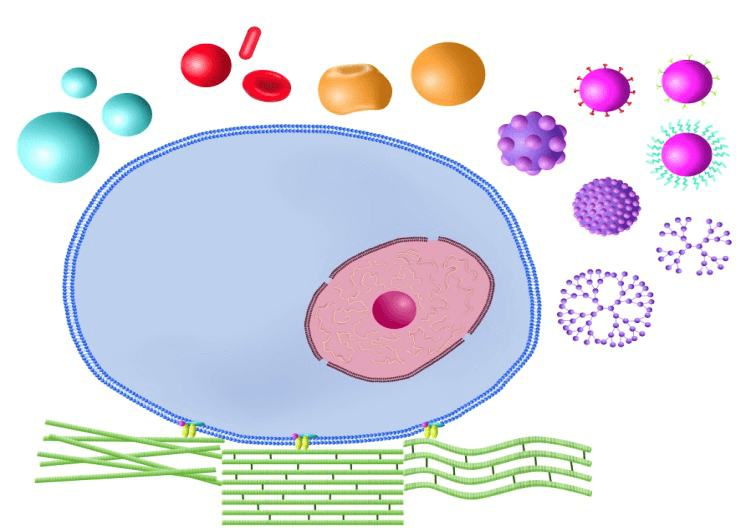
Controlling the fate of stem cells for tissue engineering
Stem cells have low immunogenicity and the ability to differentiate into various phenotypes, and can be expended in vitro, which can solve the problem of insufficient functional cells in tissue engineering and disease treatment. The fate of stem cells can be well controlled in vitro, but, it is difficult to be controlled in vivo. Regulating the properties of implants is the key to control the fate of stem cells in vivo and to the success or failure of implantation. We tried to control the fate of stem cells by regulating the physical and chemical properties (mechanical properties, surface chemistry, etc.) of materials, so as to lay a foundation for its further application in tissue engineering.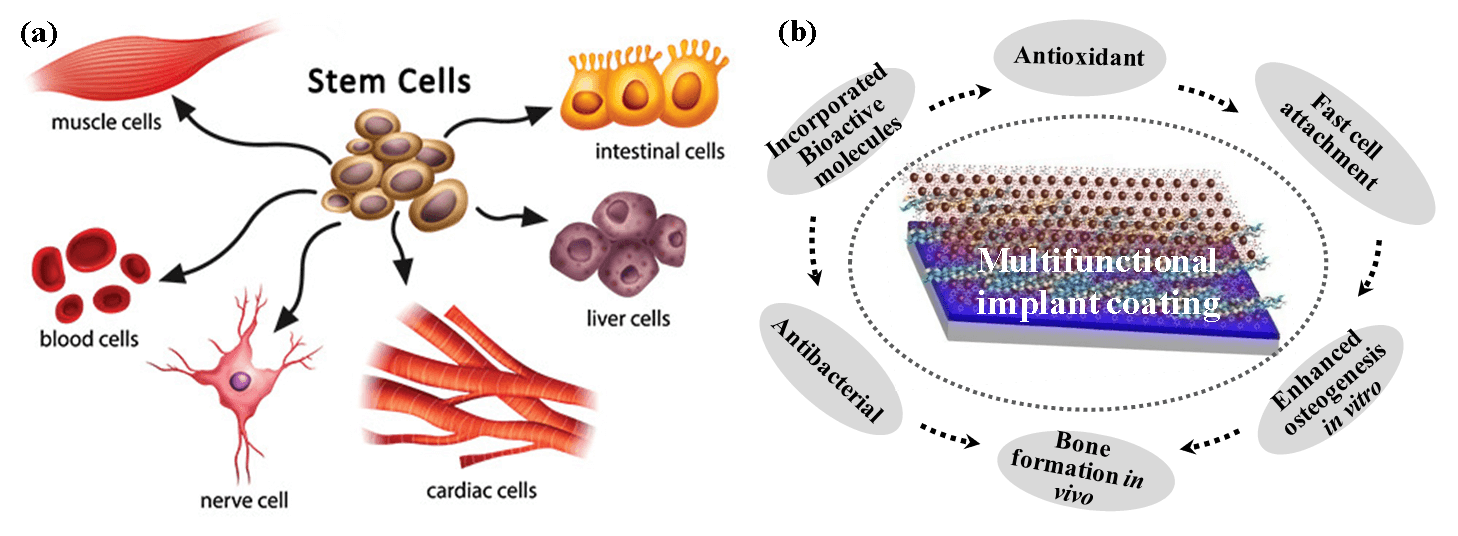
Selected publications
- Zan X, Su Z. (2009) Counterions in polyelectrolyte multilayers: A vehicle for introducing functionalities. Thin Solid Films 116-9.
- Zan X, Su Z. (2009) Incorporation of Nanoparticles into Polyelectrolyte Multilayers via Counterion Exchange and in situ Reduction. Langmuir 12355-60.
- Zan X, Kozlov M, McCarthy TJ, Su Z. (2010) Covalently Attached, Silver-Doped Poly(vinyl alcohol) Hydrogel Films on Poly(L-lactic acid). Biomacromolecules 1082-8.
- Zan X, Su Z. (2010) Polyelectrolyte multilayer films containing silver as antibacterial coatings. Thin Solid Films 5478-82.
- Zan X, Peng B, Hoagland DA, Su Z. (2011) Polyelectrolyte uptake by PEMs: Impact of salt concentration. Polym Chem-Uk 2581-9.
- Zhang X, Zan X, Su Z. (2011) Polyelectrolyte multilayer supported Pt nanoparticles as catalysts for methanol oxidation. J Mater Chem 17783-9.
- Zan X, Hoagland DA, Wang T, Peng B, Su Z. (2012) Polyelectrolyte uptake by PEMs: Impacts of molecular weight and counterion. Polymer 5109-15.
- Zan X, Hoagland DA, Wang T, Su Z. (2012) Ion Dispositions in Polyelectrolyte Multilayer Films. Macromolecules 8805-12. 9). Zan X, Sitasuwan P, Powell J, Dreher TW, Wang Q. (2012) Polyvalent display of RGD motifs on turnip yellow mosaic virus for enhanced stem cell adhesion and spreading. Acta Biomater 2978-85.
- Zan X, Feng S, Balizan E, Lin Y, Wang Q. (2013) Facile Method for Large Scale Alignment of One Dimensional Nanoparticles and Control over Myoblast Orientation and Differentiation. Acs Nano 8385-96.
- Li T, Zan X (co-first author), Winans RE, Wang Q, Lee B. (2013) Biomolecular Assembly of Thermoresponsive Superlattices of the Tobacco Mosaic Virus with Large Tunable Interparticle Distances. Angew Chem Int Edit 6638-42.
- Zan X*, (2015) Engineering Polyelectrolyte Capsules with Independently Controlled Size and Shape Langmuir 31, 7601–7608
- Zan X*, Sitasuwan P, Sheng F, Wang Q. (2016) Effect of Roughness on in Situ Biomineralized CaP-Collagen Coating on the Osteogenesis of Mesenchymal Stem Cells Langmuir 32, 1808–1817
- Wu Y, Jiang Zh,. Zan X*, Lin Y, Wang Q. (2017) Shear flow induced long-range ordering of rod like viral nanoparticles within hydrogel Colloids and Surfaces B: Biointerfaces 158, 620-626;
- Shi P, Luo S, Voit B, Appelhans D, Zan X*, (2018) A facile and efficient strategy to encapsulate the model basic protein lysozyme into porous CaCO3 J. Mater Chem. B 6, 4025-4215
- Zhang L, Hao P, Yang D, Feng S, Peng B, Appelhans D, Zhang T, Zan X*, (2019) Designing nanoparticles with improved tumor penetration: surface properties from the molecular architecture viewpoint J. Mater Chem. B 7, 953-964
- Yang S, Xu Y, Lin Q, Bai Y, Zan X*, (2019) A bio-inspired, one-step but versatile coating onto various substrates with strong antibacterial and enhanced osteogenesis Chem Comm 55, 2058-2061
- Shi P, Qin J, Hu J, Bai Y, Zan X*, (2019) Insight into the mechanism and factors on encapsulating basic model protein, lysozyme, into heparin doped CaCO3 Colloids and Surfaces B: Biointerfaces 175, 184-194;
- Huang W, Hao P, Qin J, Luo S, Zhang T, Peng B, Chen H, Zan X*, (2019) Hexahistidine-metal assemblies: A promising drug delivery system Acta Biomater 441-452.
- Huang W, Zhang T, Shi P, Yang D, Luo S, Voit B, Appelhans D, Chen H, Zan X*, (2019) The construction and effect of physical properties on intracellular drug delivery of poly(amino acid) capsules Colloids and Surfaces B: Biointerfaces 177, 178-187
- Meng L, Li H, Pan Q, Gao C, Wang Y, Yang S, Zan X*, Guan Y, (2019) Graphene Oxide and Lysozyme Ultrathin Films with Strong Antibacterial and Enhanced Osteogenesis. Langmuir 6752-6761.
- Zhang L,Wang Y, Yang D, Hao P, Feng S, Appelhans D, Zhang T, Zan X*, (2019) Shape effect of nanoparticles on tumour penetration in monolayers versus spheroids Molecular Pharmaceutics 7, 2902-2911 I
- Yang S, Wang Y, Luo S, Shan C, Geng Y, Zhang T, Sheng S, Zan X*, Building polyphenol and gelatin films as implant coating, evaluating from in vitro and in vivo performances Colloids and Surfaces B: Biointerfaces 181, 549-560;
- Shi, P; Qin, J; Wu, X; Wang, L; Zhang, T; Yang, D; Zan X*, A Facile and Universal Method to Efficiently Fabricate Diverse Protein Capsules for Multiple Potential Applications ACS Applied Materials&Interfaces 39209-39218
- Yang Z, Wang P, Zhang Y, Zan X*, Zhu W, Jiang Y, Zhang L, Improved Ozonation Efficiency for Polymerization Mother Liquid from Polyvinyl Chloride Production Using Tandem Reactors Molecules DOI:10.3390/molecules24244436
- Yang S, Wang Y, Wu X, Sheng S, Wang T, Zan X*, Multifunctional Tannic Acid (TA) and Lysozyme (Lys) Films Built Layer by Layer for Potential Application on Implant Coating ACS Biomaterial Science&Engineering 3582-3594